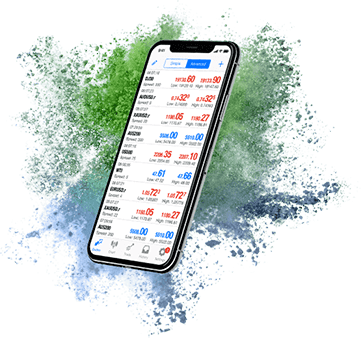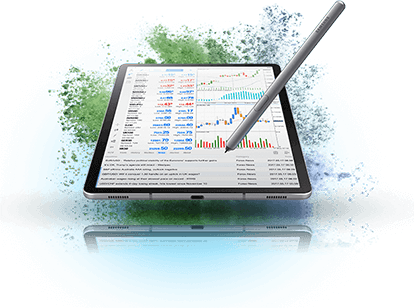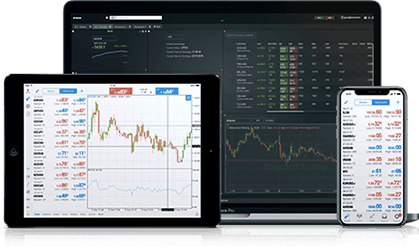Experience Trading
on the Go
on the Go
How Index
CFDs Connect
You to
the
Global Market?
Index CFD trading is a great way to gain exposure to different economies and sectors across global financial markets. This category of trading instruments has gained immense popularity, particularly in well-diversified investment portfolios. The following is an in-depth look into Index CFD trading, its features, benefits and tips on how to trade them.


What is
Index Trading?
Trading stock indices is a low risk way to participate in the stock market. A stock index is essentially a collection of stocks from a specific sector or market that is listed on the same exchange. The stocks are grouped together to offer insight into the performance of that particular index.
Index trading offers investors broader exposure to the stock market compared to investing in a single stock. Risk exposure is lower as the volatility of a single stock will not impact the performance of the overall index. Some examples of stock indices are the Dow Jones Industrial Average, S&P/ASX 200 and the FTSE 100.
Unlike stock trading, where you buy shares in an individual company, index trading is usually conducted through derivative instruments such as contracts for difference (CFDs).
What are the Benefits
of Index Trading?
Index trading offers a great way to gain exposure to the global financial markets, without having to monitor the performance of individual stocks. Indices are a simple way to determine the overall health of the market segment or economy of the country the index belongs to. Moreover, historical price data offers traders an effective means to identify how the market tends to react to specific geo-political events or economic releases.
Some of the other key advantages of trading indices are:

Trade Rising and Falling
Markets
Since index trading is usually done through derivatives, like CFDs,
traders have more trading opportunities than they would by investing in individual stocks. This is
due to the fact tht they can speculate on both rising and falling prices. The ability to go
either long or short on a trade is a major attraction in the CFD market.

Higher Liquidity
The futures market
is usually a very liquid one, with thousands of traders available in the market at any point
of time. This means that you are likely to find a trader on the other side of your trade
whenever you wish to take a position. In a liquid market, trades can be made quickly with
price movements capitalised on due to the ability to transact. High liquidity also leads to
tight spreads which minimises the costs of trading.

Portfolio Diversification
Index
trading is a great way to diversify your portfolio with a single investment. This is because
a single index consists of a large number of prominent stocks. Those with portfolio's
heavily weighted by a particular sector can hedge their position by investing in an index
that generally moves in the opposite direction. This is a common method used to trade
indices.

Trade with Leverage
When you enter a
futures contract CFD you can use leverage to increase the size of your position. Leverage
means that the trader invests only a small percentage of the total trade value (margin
requirement), while the broker puts in the remaining amount. For instance, regulated brokers
might offer leverage of 200:1. This means that for every $1 you invest, the broker will lend
you $200 to fulfil the position. As a result, you can open a position worth $100,000 with an
initial investment of only $500 from your trading account.
It is important to remember
that using highly leveraged products magnifies both potential profits and losses. Therefore,
it is crucial to put robust risk management measures in place while using leverage.

Which are the
Most Popular Indices
to Trade?
Every stock exchange has its own benchmark stock index, while some exchanges have multiple indices. The basket of stocks in each index is ranked by independent financial institutions, such as the Deutsche Börse or the FTSE Group. The basket sizes of indices differ. Some include 100 listed companies of an exchange, while others list 30 or 40 stocks listed on a specific stock exchange. The most traded indices are:
Dow Jones Industrial Average (DJIA)
Established in 1896, the Dow Jones is one of the oldest indices in the world. It is made up of a basket of 30 industrial companies in the United States. It remained the most important barometer of the US dollar (USD) and stock market until World War II, after which the S&P 500 gained importance. However, it still is a good gauge of the US economy.
Standard & Poor’s 500 Index (S&P 500)
This index comprises of the 500 of the largest companies on the NYSE and NASDAQ by market capitalisation. Given the diversity of the stocks on this index, it is one of the most traded indices in the world and represents about 80% of the American stock market.
NASDAQ 100
The NASDAQ Composite or NASDAQ 100 consists of up to 103 of the largest technology stocks listed on the NASDAQ exchange. Giants like Google, Amazon and Facebook are part of this index. This makes the index not just an American one, but one that reflects the global technology sector.
Financial Times Stock Exchange 100 Index (FTSE 100)
The FTSE 100 represents about 81% of the UK stock market, consisting of the top 100 companies listed on the London Stock Exchange. Some of the biggest names in the UK, such as SBC, BP and Unilever are part of this index.
Deutscher Aktienindex (DAX 30)
This is a German index that consists of the top 30 stocks listed on the Frankfurt Stock Exchange. It is a good indicator of the health of the German economy but tends to be more volatile than the S&P 500 and FTSE 100.
Cotation Assistée en Continu (CAC 40)
Established in 1896, the Dow Jones is one of the oldest indices in the world. It is made up of a basket of 30 industrial companies in the United States. It remained the most important barometer of the US dollar (USD) and stock market until World War II, after which the S&P 500 gained importance. However, it still is a good gauge of the US economy.
EURO STOXX 50
This index consists of 50 of the leading blue-chip stocks from 9 countries of the Eurozone including Germany, France, Belgium, Ireland, Finland, Italy, Netherlands, Luxembourg and Spain.
Nikkei 225
One of the most active stock markets in Asia, Japan, uses the Nikkei as its benchmark index. This index consists of 225 of the largest companies, by market capitalisation, listed on the Tokyo Stock Exchange. Created just after World War II, this index has been part of Japan’s rise during the 1980s and the lows of 2009.
Hang Seng Index
The best known Asian index, after the Nikkei, is Hong Kong’s Hang Seng. This index comprises 50 stocks, although a large percentage of the stocks are that of China-based companies, such as BOC and ICBC. Many traders see this index as a “proxy” for the Chinese economy.
SSE Composite (SSE Index)
This index lists the top stocks on the Shanghai Stock Exchange. Since this stock exchange is not entirely accessible for foreign investors, the SSE offers a route to invest in the Chinese economy.
FTSE Straits Times Index (STI)
The STI is the benchmark index of the Singapore stock exchange. It comprises 30 of the leading companies listed on this exchange.
S&P/ASX 200
The benchmark index of the Australian Securities Exchange (ASX), this index is maintained by Standard & Poor’s, hence its name, S&P/ASX 200. In April 2000, this index took over from the All Ordinaries to become Australia’s main investment benchmark. It represents about 81% of the Australian stock market.
What are CFDs?
A contract for difference (CFD) is possibly the most popular method of derivative trading. A derivative is a financial contract the value of which is based on an underlying financial asset. It trades like any other financial asset in the global trading marketplace. CFDs are a type of financial derivative that allow traders to gain exposure to the price movements in the underlying asset without actually owning the asset.
The price of the CFD is based on the entry and exit prices of the underlying asset, thereby considering only the price change without taking into account the asset's actual market price. Since it considers only price fluctuations, this instrument offers trading opportunities in both rising and falling markets.
The underlying asset could be any financial security. Traders can purchase share CFDs in Apple, Microsoft or Amazon, commodities (oil, coffee or wheat), or cryptocurrencies (Bitcoin, Ethereum or ripple).
Since the turn of the millennium, CFD trading has gained immense popularity for speculating on financial markets as well as a hedging tool for diversification of investor portfolios. Forex brokers are one of the biggest CFD providers as they have the technology and platforms required to complete transactions. In terms of trade size and turnover, forex is one of the biggest financial markets in the world.
What are the Benefits
of Trading CFDs?
The popularity of CFDs is built on the many advantages that they offer. Here are some of the main benefits of trading CFDs:

Easy to understand
Unlike other
financial derivatives, like futures, forwards, and swaps, CFDs are incredibly easy to
understand and simple to trade. This is particularly true if you have some experience
trading stocks, currencies, commodities, or cryptocurrencies.

Higher Leverage
CFDs are highly
leveraged financial products. This offers immense profit potential, although it’s important
to remember that this comes at heightened risk. Leverage provides increased exposure to an
underlying asset, as the trader needs to put down only a small portion of the full value of
the trade. This benefits those looking to make high amounts of short-term trades.
Here’s how CFD leverage trading works: Let’s say you wish to buy 10 shares of Company A and each share costs $100. Going by traditional trading, you would need $1,000 to gain the desired exposure. Now let’s assume that Company A’s share price rises by $20. Now each share is worth $120. This means you can sell your 10 shares for $1,200, making a profit of $200. If the market had moved in the opposite direction, taking Company A’s share price down by $20, each share would have been worth $80. If you decided to sell your shares of Company A at this time, they would sell for $800 and you would book a loss of $200.
Now let’s throw in some leverage into the trading. Let’s say your broker offers 50:1 leverage. To gain exposure to 10 shares of $100 each, you would need to put down only $20. When the market moves favourably, your profits are still $200. However, you have earned this with a much lower investment of only $20 (versus $1,000 with traditional trading).

No barriers to entry
Most traders
find it extremely easy to switch from trading assets to CFD trading. In fact, investors with
exposure to some key assets trade CFDs in those very assets to hedge associated risk. These
financial instruments can be traded on the world's most popular trading platforms –
MetaTrader 4 (MT4) and MetaTrader 5 (MT5). It is easy to open an account and start trading.
People that trade currency pairs such as the EUR/AUD on these platforms can also access CFDs
in other financial instruments.

Wide variety of assets
Trading
opportunities are immense with CFDs, as brokers offer these instruments to trade stocks,
indices, currencies, commodities and now even cryptocurrencies.

Similarity to the underlying
asset
The price of a CFD moves in tandem with the price of the underlying
asset. Therefore, the variables impacting CFD price fluctuations are broadly the same as
those that cause price movements in the underlying asset. This makes it easy to hedge the
exposure that you may have to a financial instrument. The liquidity of CFDs also mirrors the
liquidity in the underlying market.

No need to own the underlying
asset
CFD trading does not involve the buying or selling of the underlying
asset. This means you don’t need to own or take delivery of the asset. The other benefits of
CFD trading are lower transaction costs, transparency in execution, and extended hours of
trading.

What are
Index CFDs?
Index CFDs make use of contracts for difference to trade the world’s most popular stock indices. The price fluctuations in index CFDs are linked to the performance of the equity index. If the stock index rises, the price of the index CFD will also go up.
What are the Most
Common Index CFDs?
Just like its price and liquidity, the popularity of an index CFD is also derived from the popularity of the underlying index. This means that the most traded indices are the most popular index CFDs.
Among the most popular indices are AUS200 (Australia 200 index), US30 (also known as the Dow Jones Industrial Average), EURO50 (also known as the EURO STOXX 50), JP225 (also known as the Nikkei), US500 (also known as the S&P 500), US Tech 100 (also known as the Nasdaq 100) and UK100 (also known as the FTSE 100).
How Index CFDs
Connect You to the
Global Market?
One of the best features of Index CFDs is that they enable traders to gain exposure to global markets from a single account. This means that you can speculate on the price movements in major indices around the world.
There are Index CFDs that cover all the key indices around the world, enabling traders in one country to participate in global markets. From Australia’s AUS200 to Japan’s JP225, from the Eurozone’s EURO50 to America’s S&P 500 and from Britain’s UK100 to China’s CHINA50, you can gain exposure to any of these indices by trading Index CFDs.
Unlike most stock trading, you do not need to be based in the country to which the particular index belongs. Let’s say you reside in Australia and are trading with an ASIC regulated provider of CFD trading services. You wish to gain exposure to your favourite American tech stocks, like Apple, Google, Facebook, Amazon, and Microsoft. You can use your Australian broker’s platform and the live account opened with them to trade CFDs for the US Tech 100 index. You can also trade CFDs for France’s FRA40 index, Hong Kong’s HK50 index, and Singapore’s SING30 index to diversify your portfolio.
As you do not need to own the underlying stocks, you are not limited to trading on the exchanges to which those stocks belong.
By connecting traders to the global market, Index CFDs are considered a great way to achieve diversification. If the stock market in your home country begins declining, your investments in foreign equity markets can mitigate this risk. On the other hand, if you are bullish on the prospects of a particular economy, you can gain exposure to that by CFD trading in the benchmark index of that country.


What are the
Best Tips for Trading
Index CFDs?
Here are some top tips for trading Index CFDs:

Use stop-loss orders
As with any
other asset class, the first rule in trading Index CFDs is to use stop-loss orders with
every trade. Such an order does exactly what its name suggests. It stops you from incurring
unplanned losses. When you place a stop-loss order, you calculate and account for how much
you are willing to lose should the market move against you. There are no surprise and shocks
to deal with, as your loss is limited to what you had planned for.
There are different kinds of stop-loss orders. Among the most common is the trailing stop. Some traders place a specific percentage (like 5% or 6%) on trailing stops on all securities rather than calculating for each instrument and each trade. Some traders also use the most recent support price for stop-loss placement.

Use a demo account first
Avoid
jumping into any form of trading even if you have experience in other financial instruments.
It’s best to trade on the demo account with virtual money and test your Index CFD trading
strategies before trading with the live account. Most CFD providers provide demo accounts
which is an added benefit for those wanting to learn without jeopardising their financial
situation.

Get familiar with the indices
Read
up on the benchmark indices of the economies you wish to gain exposure to. Knowing which
variables impact them will be helpful in decision making. Stay abreast of the most impactful
economic data (like GDP, interest and inflation rates, business and consumer sentiment,
trade balance, etc.) to decide which Index CFDs to trade. It may also be worthwhile to keep
in touch with the political news and events in those countries.

Have a basic understanding
of market correlations
Since Index CFDs are related to a basket of stocks,
there are various market correlations that impact them. For instance, a downturn in the US30
may hurt sentiment and act as a drag on the US Tech 100. Even an upturn in the US stock
market can cause European and Asian indices to rise. The performance of a sector can also
impact the price of Index CFDs. The currency of the country has a meaningful impact on the
benchmark indices.

Avoid trading all indices
You may
feel that exposure to all the global markets will result in the best diversification.
However, this may not always be the case. For instance, many economies exhibit similar
trends. For instance, the AUS200 may be impacted by CHINA50, because China is Australia’s
largest trading partner. So, gaining exposure to both may not lead to the best
diversification. Also, it can be overwhelming to stay abreast of all these economies.

Limit leverage
Index CFDs can be
traded with very high leverage. Some brokers offer as much as 500:1 leverage. While this may
sound exciting, it also magnifies risks.
Most importantly, once you have developed a trading strategy for trading Index CFDs, don’t abandon it at the first sign of an unfavourable price movement. Avoid making rash decisions. As long as you’ve done your homework, it is a good idea to avoid jumping from one strategy to another in the heat of the moment.
 Access 10,000+ financial instruments
Access 10,000+ financial instruments Auto open & close positions
Auto open & close positions News & economic calendar
News & economic calendar Technical indicators & charts
Technical indicators & charts Many more tools included
Many more tools included
By supplying your email you agree to FP Markets privacy policy and receive future marketing materials from FP Markets. You can unsubscribe at any time.
Source - cache | Page ID - 965